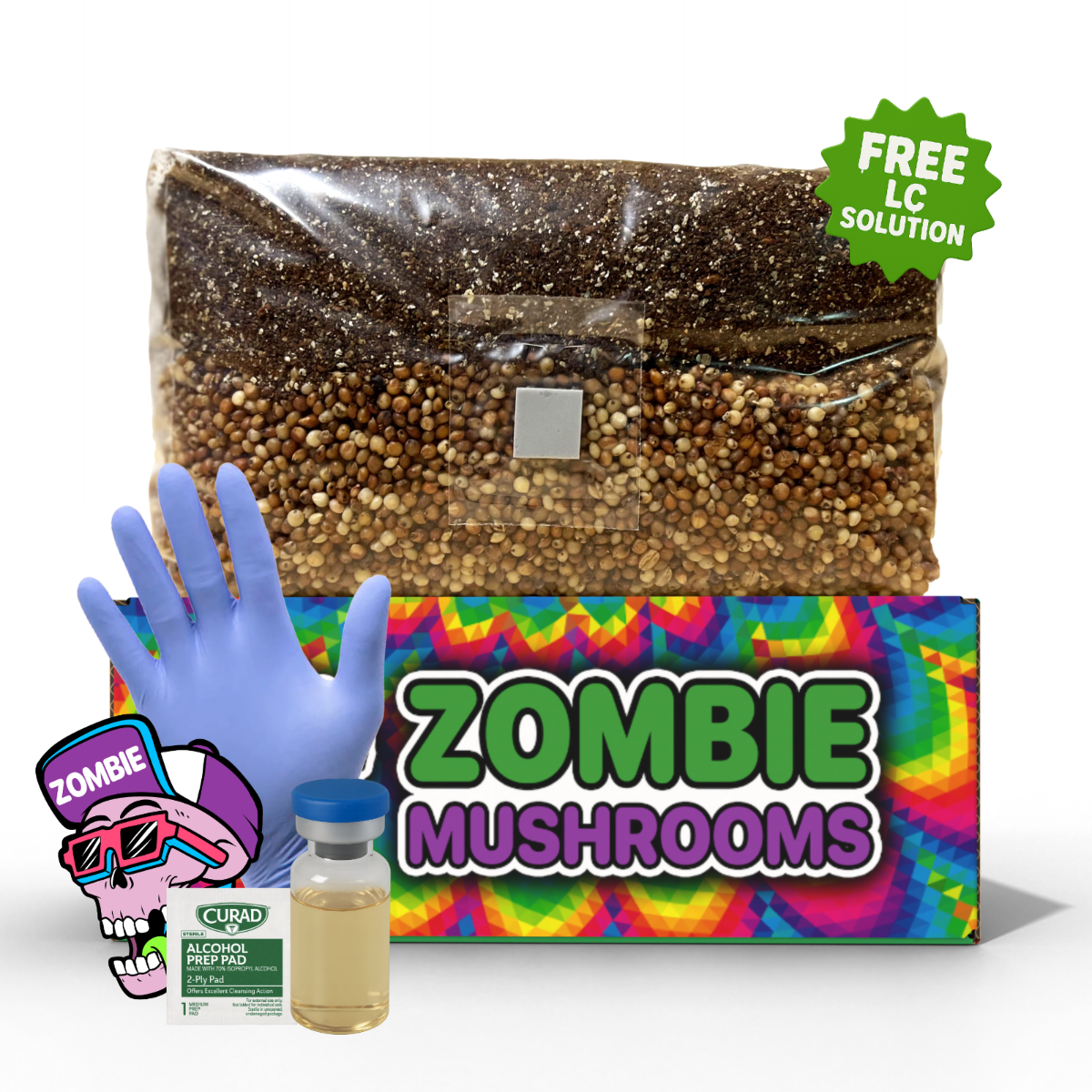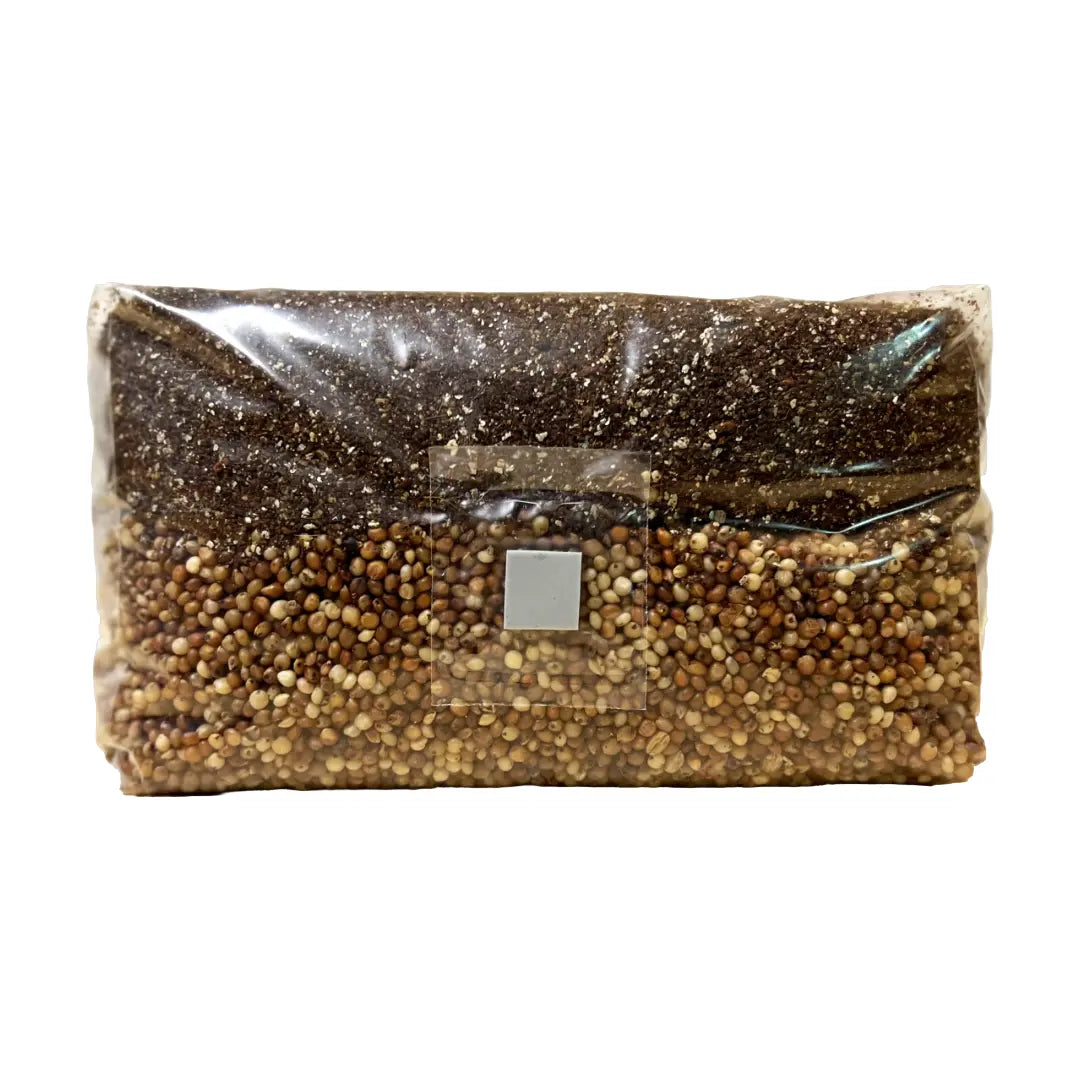1. Introduction: Why Build an Outdoor Mushroom Bed?
Outdoor mushroom beds are a powerful way to grow mushrooms at home—one of the best-value garden mushroom bed setups you can build. They use simple, natural materials like wood chips, straw, and compost, making them both sustainable and affordable. While outdoor beds offer excellent yield potential in the right conditions, tools like mushroom grow bags provide indoor gardeners with structure, cleanliness, and consistent results year-round. In this guide, you'll learn how to make outdoor mushroom beds, pick the best mushroom varieties for your climate, prepare your bed properly, and maintain it for long term success.
-
Simplicity and Low Maintenance: Once set up, an outdoor mushroom bed largely mimics natural processes and needs very little supplemental care.
-
Environmental Contributions: Mushrooms play an important part in garden ecosystems. By breaking down organic matter, they improve soil structure and fertility, releasing vital nutrients for plants. Mushrooms are also excellent for composting and mulch beds, reducing overall garden waste.
-
Increased Yield: Outdoor mushroom beds, given the space and natural setting, often produce larger and more consistent yields than indoor mushroom kits.
This guide will dive into creating such a bed, helping you grow popular mushroom varieties like Wine Cap (Stropharia rugosoannulata), Oyster (Pleurotus spp.), Almond Agaricus (Agaricus subrufescens), and Blewit (Clitocybe nuda). By the end, you'll be equipped with the knowledge to grow mushrooms that benefit both your garden and culinary ventures.
2. Best Mushroom Varieties for Your Outdoor Bed
Choosing mushroom species that suit your climate and bed materials is key:
-
Wine Cap (Stropharia rugosoannulata): Excellent for beds with hardwood chips or straw; tolerates heat and helps break down organic matter.
-
Oysters (Pleurotus spp.): One of the fastest fruiting types; thrives on a variety of wood-based substrates, often producing multiple flushes.
-
Almond Agaricus (Agaricus subrufescens): Prefers nutrient-rich soil or compost, shaded beds, and a slower build-up, but gives gourmet flavor.
-
Blewit (Clitocybe nuda): Works well in cooler weather, in leaf mulch or decomposed organic materials, making it great for autumn beds or shady areas.
These varieties offer flexibility—and choosing ones adapted to your region increases success for your garden mushroom bed setup.
Considerations for Your First Outdoor Mushroom Bed:
If you are just starting out or want an easy head start, consider using pre-made mushroom grow kits. These kits simplify the cultivation process by providing ready-to-use spawn and detailed instructions suitable for garden environments. You can also source spawn from reputable suppliers for specific mushroom varieties that suit your garden’s microclimate.
3. How to Build a Productive Outdoor Mushroom Bed
-
Choose the Ideal Site: Look for shaded areas with filtered sunlight—under trees, beside hedges, or near garden structures. Avoid places flooded by runoff or exposed to harsh sun that dries out substrate.
-
Select Materials Smartly: Use hardwood chips, straw, compost, or even cardboard depending on variety. Almond Agaricus does better in rich composted soil; Wine Caps and Oysters thrive with wood chip beds.
-
Layering & Construction Steps:
-
Lay down a base of wood chips/straw ~3–6 inches deep.
-
Spread spawn evenly over substrate; use wide grain spawn or sawdust spawn depending on the species.
-
Top with more substrate to cover spawn, then mulch with straw to retain moisture.
-
Water well initially, then maintain dampness—not soggy—while ensuring drainage to prevent waterlogging.
-
4. Materials and Tools You Will Need
Building an outdoor mushroom bed is a straightforward and cost-effective process. However, sourcing the right materials and tools will ensure a lasting and productive mushroom-growing system.
Essential Materials:
-
Mushroom Spawn: The key component of any mushroom-planting endeavor. Spawn can be purchased in different types—grain spawn, sawdust spawn, or even plugs (used for logs). Always choose the spawn type and form that suit the mushroom variety and substrate you're working with.
-
Substrate Materials: Different mushroom species require distinct growing mediums.
-
Wine Caps and Oysters: Benefit from a substrate of wood chips, straw, or cardboard.
-
Almond Agaricus: Needs compost, manure, or nutrient-dense soil for optimal growth.
-
Blewit: Prefers leaf mulch and partially decomposed organic material.
-
-
Moisture Control Tools: Mushrooms need consistent and even moisture for good yields. Consider investing in a moisture meter to accurately monitor moisture levels in your mushroom bed.
-
Barrier Materials: Organic debris (like straw or hay) can be used to suppress weeds and protect the substrate. Adding a layer of plastic mesh or lightweight fencing can prevent small animals like squirrels or birds from digging into your project.
Tools to Make the Job Easier:
-
Garden spade: Essential for preparing the substrate and loosening soil.
-
Buckets or Wheelbarrows: For easy transport of substrate materials.
-
Watering Can or Hose: To provide consistent moisture to your mushroom bed without over-saturating it.
-
Rakes & Shovels: Tools to spread substrate and create a proper bed structure.
5. Step-by-Step Guide to Creating a Wine Cap Mushroom Bed
Wine Cap mushrooms (Stropharia rugosoannulata) are one of the premier choices for outdoor mushroom beds due to their hardiness and ability to grow in simple woodland-like conditions. Here's how you can get started:
-
Site Selection: Select a shaded area that's well-drained. The bed can be integrated within your garden paths, under trees, or alongside plants that benefit from the additional organic matter breakdown.
-
Substrate Preparation: Wine Caps thrive on hardwood chips, straw, or cardboard. It's critical to use hardwoods (such as oak or maple) as a base material since softwoods may impede the fungus's growth.
-
Layering Process:
-
Watering: Keep the mushroom bed moist but not waterlogged. You want to emulate a forest floor—a damp but breathable environment.
-
Harvesting: Wine Caps typically fruit within 4-6 months under ideal conditions. You can expect large cap-shaped fruiting bodies that can extend throughout the growing season.
Pro Tip: Adding a thick layer of straw acts as a mulch to prevent moisture loss and protect the mushrooms from competitor fungi and pests.
6. Step-by-Step Guide to Creating an Oyster Mushroom Bed
Oyster mushrooms (Pleurotus spp.) are incredibly versatile and fast-growing. Here's how you can create an outdoor bed to yield multiple flushes of this delicious mushroom.
-
Site Selection: Choose a location in partial shade, such as under trees or alongside tall plants. Oysters also benefit from integration near vegetable plots.
-
Substrate Preparation: Oysters commonly thrive on hardwood chips, straw, or a mix of both. Soak the substrate for a few hours to hydrate it fully before setting up the bed.
-
Spawn Inoculation: Once your substrate is ready, mix the sawdust spawn throughout the layers or scatter grain spawn on top of the substrate, working it into the surface to ensure even inoculation.
-
Maintaining Moisture: Use a garden hose or watering can to keep the bed just moist enough. Avoid overwatering, as excess moisture can hinder growth.
-
Harvesting: Depending on the climate, Oyster mushrooms are fast fruiters and typically flush 45-60 days after inoculation. They can fruit several times, especially if conditions (humidity, shade, and moisture) are carefully managed.
7. Step-by-Step Guide to Creating an Almond Agaricus Mushroom Bed
Almond Agaricus (Agaricus subrufescens) is a gourmet delight that thrives in nutrient-packed compost or manure-enriched soil. Here's how you can create a productive outdoor bed for them:
-
Pick a Site: Almond Agaricus mushrooms prefer enriched environments, so you may want to prepare a bed using a compost pile or even add them into raised garden beds rich in organic matter.
-
Substrate Setup: Use nutrient-packed materials like compost, manure, sawdust, or straw. A good rule is that the more nutrient-dense the environment, the better the crop.
-
Spawn Integration: Mix your Almond Agaricus spawn evenly through the compost pile or into existing garden soil. The mushrooms will use the organic material as food and begin colonizing.
-
Moisture Maintenance: Keep your substrate properly moist for the mushroom spawn to colonize. Almond Agaricus mushrooms do best in ambient humidity.
-
Harvest Timing: Expect your first Almond Agaricus mushrooms in about 3-6 months. Once ready, harvest regularly by gently twisting the mature mushrooms from their base.
8. Step-by-Step Guide to Creating a Blewit Mushroom Bed
Blewit mushrooms (Clitocybe nuda) perform best when cultivated in cool temperatures using leaf mulch and compost.
-
Choose the Right Season: Since Blewits are cool-loving species, set up the bed in early autumn or spring when the temperature hovers around 65°F or lower.
-
Substrate Prep: Gather fallen leaves, compost, and mulch to create your Blewit bed. These materials mimic the mushroom’s natural environment in forests where organic matter is decomposing.
-
Inoculate with Spawn: Spread Blewit spawn evenly over the bed, and lightly rake it into the substrate to ensure proper integration.
-
Maintain Moisture Levels: Blewits require regular moisture to grow. A watering regime that ensures the bed stays damp is critical, especially when rainfall is low.
-
Harvesting: Depending on your climate, expect Blewit mushrooms to fruit within 4-5 months. They typically emerge in late autumn and can continue producing through a mild winter.
9. Integrating Mushroom Beds into Your Garden
Mushroom beds are versatile and can blend seamlessly with your existing garden designs to both beautify and enhance your ecosystem. Here are a few ways to integrate mushrooms into your garden landscape effectively:
-
Companion Planting: Growing mushrooms alongside moisture-loving plants like lettuce, spinach, and various leafy greens is highly effective. The mushrooms improve soil structure, which boosts the overall health of companion plants.
-
Beneath Trees & Bushes: Utilize the natural shade under trees and hedges to plant mushroom beds. For example, planting Wine Caps in mulch beneath fruit trees can help regulate moisture levels for the tree while providing rich organic material.
-
Pathway Fun: Incorporating mushrooms into garden paths made from wood chips can turn commonly overlooked spaces into productive growing areas.
-
Natural Borders: Use mushrooms to create natural garden borders that also enhance biodiversity and insect habitats.
10. Maintaining Your Outdoor Mushroom Bed
Maintenance of a mushroom bed is easier than traditional garden plots, but routine care is still essential for optimal results. Here’s what to keep an eye on:
-
Moisture Regulation: Without proper moisture, mushroom mycelium might dry out and stall growth. Regularly check the soil using a moisture meter to ensure it stays appropriately damp, especially in dry climates.
-
Pest Control: Fungi-eating pests such as slugs, rodents, and even some insects are attracted to mushroom beds. Physical barriers, such as mesh, or organic methods like diatomaceous earth can keep pests away without disturbing the mycelium.
-
Substrate Renewal: Over time, your mushroom bed’s substrate will break down, and adding fresh layers of straw, mulch, or wood chips will help keep the mushroom bed producing.
-
Weed Control: While mushrooms are resilient, they can be vulnerable to competition from other fungi. Continuously monitor your bed for invasive fungal species or mold, removing affected substrate areas immediately to prevent the spread.
11. Harvesting Timing and Techniques
Proper harvesting techniques ensure long-term productivity:
-
Wine Cap: Harvest these mushrooms 4-6 months after planting. Look for well-formed caps (before they flatten out), as they are the most tender at this stage.
-
Oyster: Oyster mushrooms should be harvested once the caps have unfurled, usually 1-2 months after inoculation. Each flush may be harvested at regular 1-3 week intervals.
-
Almond Agaricus: Mature Almond Agaricus mushrooms are ready for harvest when you detect a slight almond scent within the compost bed, typically around 4 months after inoculation. Monitor them as they mature for frequent harvests.
-
Blewit: Blewit mushrooms naturally thrive in cool seasons (4-5 months after planting), but don’t wait too long to harvest as their tender flesh can break down quickly.
For best results, gently twist mushrooms from their stems rather than cutting them — this technique keeps the growing mycelium intact for future flushes.
12. Common Challenges & How to Address Them
1. Overwatering
Overly saturated mushroom beds can inhibit the growth of mycelium. Monitor moisture and drainage carefully. Adding materials like perlite or different planting layers can create a balance by improving air circulation and soil aeration.
2. Pest Problems
Slugs, rodents, or insects may frequent your mushroom beds. Tackle this problem by installing physical barriers or using non-toxic pest repellents such as copper tape, which prohibits slug movements.
3. Competing Fungi & Contaminants
Competing fungi can naturally intermix in outdoor environments. If you spot unfamiliar mold or fungi, it’s essential to quickly remove the affected area with a small shovel and dispose of it away from the bed.
13. Mushrooms as a Resilient Garden Resource
The sustainability benefits of mushrooms can't be overstated. Not only do they help in breaking down garden waste, but they turn hard-to-decompose materials like wood or straw into nutrients for your garden. They’re a powerful partner in enhancing your garden’s overall health:
-
Breaking Down Organic Materials: Mushrooms’ natural ability to break down lignin and cellulose means they convert organic waste into soil-boosting materials. Thus, mushrooms add humus to the soil, further improving soil nutrient content.
-
Biodiversity Boost: A healthy mycelium growth expands biodiversity in your garden, promoting a balanced and robust ecosystem.
-
Low-Resource Gardening: Unlike many crops that require fertilizers, regular watering, and constant care, mushrooms can thrive with minimal energy input, making them an eco-friendly investment for sustainable gardens.
14. Product Recommendations for Outdoor Mushroom Beds
For those looking to start but needing a complete solution, consider purchasing mushroom grow kits tailored to outdoor gardening needs. Our kits include mushroom spawn, substrate materials, and detailed guides following the outlined steps in this guide.
For advanced gardeners, consider bulk spawn packages, which allow more flexible custom setups – whether you’re composting a large garden plot or inoculating fallen logs. Specialty substrates, such as pre-mixed hardwood chips for particular mushroom varieties, are also available in eco-friendly packaging.
15. FAQ
-
How long Does an Outdoor Mushroom Bed Take to Produce?
Depends on species: Wine Cap often fruits in about 4-6 months; Oysters can flush in 1-2 months; Almond Agaricus and Blewit may take longer, often 3-6 months. -
Can I grow mushrooms outdoors if I only have a small yard or partial shade?
Yes. Choose shade-tolerant varieties (like Oysters), use smaller bed areas, and mulch well to retain moisture. Even shady corners can work well. -
How often should I water an outdoor mushroom bed?
Keep the substrate consistently damp. After rain, less work; during dry periods, water a few times a week but avoid waterlogging. -
How do I prevent pests and mold in outdoor beds?
Use barriers like mesh or netting, keep the mulch layer clean, remove dead plant material, and ensure good airflow around the bed. -
Do I need to renew or refresh the bed over time?
Yes—substrate breaks down. Adding fresh wood chips or mulch annually helps maintain production. Beds may need rebuilding or additional spawn for longer-term yield.
16. Key Takeaways
-
Start with the Right Species: Choose mushroom types like Wine Cap, Oyster, Almond Agaricus, or Blewit based on your climate, substrate availability, and garden goals.
-
Environment Matters: Shady, cool, and well-drained garden locations are ideal mushroom bed setups.
-
Substrate Selection: Use materials like wood chips, straw, sawdust, compost, or manure, depending on your chosen mushroom species.
-
Moisture is Critical: Consistently monitor and adjust moisture levels for optimal growth and successful harvests.
-
Pests and Competitors: Protect your beds from pests and mold by using physical barriers and careful observation.
-
Harvest Timings: Knowing mushroom fruiting timelines (4-6 months for Wine Cap; 1-2 months for Oysters) is key to maximizing yield.
-
Ongoing Care: Renew substrates and mulch periodically, and ensure proper moisture and pest protection for longer-lasting mushroom production.
16. CTA: Start Your Outdoor Mushroom Bed Today!
Ready to embark on your mushroom-growing journey? Visit our online store to browse a wide selection of outdoor mushroom grow kits, specifically designed for Wine Cap, Oyster, Almond Agaricus, and Blewit mushrooms. With our easy-to-use kits and dedicated instructions, you’ll enjoy fresh, homegrown mushrooms while enhancing your garden’s ecosystem. Share your garden adventures with the hashtag #OutdoorMushroomGardening and join the thriving community of mushroom cultivators today!
















